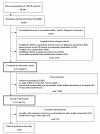The influence of age, gender and socio-economic status on multimorbidity patterns in primary care. First results from the multicare cohort study
- PMID: 22471952
- PMCID: PMC3348059
- DOI: 10.1186/1472-6963-12-89
The influence of age, gender and socio-economic status on multimorbidity patterns in primary care. First results from the multicare cohort study
Abstract
Background: Multimorbidity is a phenomenon with high burden and high prevalence in the elderly. Our previous research has shown that multimorbidity can be divided into the multimorbidity patterns of 1) anxiety, depression, somatoform disorders (ADS) and pain, and 2) cardiovascular and metabolic disorders. However, it is not yet known, how these patterns are influenced by patient characteristics. The objective of this paper is to analyze the association of socio-demographic variables, and especially socio-economic status with multimorbidity in general and with each multimorbidity pattern.
Methods: The MultiCare Cohort Study is a multicentre, prospective, observational cohort study of 3.189 multimorbid patients aged 65+ randomly selected from 158 GP practices. Data were collected in GP interviews and comprehensive patient interviews. Missing values have been imputed by hot deck imputation based on Gower distance in morbidity and other variables. The association of patient characteristics with the number of chronic conditions is analysed by multilevel mixed-effects linear regression analyses.
Results: Multimorbidity in general is associated with age (+0.07 chronic conditions per year), gender (-0.27 conditions for female), education (-0.26 conditions for medium and -0.29 conditions for high level vs. low level) and income (-0.27 conditions per logarithmic unit). The pattern of cardiovascular and metabolic disorders shows comparable associations with a higher coefficient for gender (-1.29 conditions for female), while multimorbidity within the pattern of ADS and pain correlates with gender (+0.79 conditions for female), but not with age or socioeconomic status.
Conclusions: Our study confirms that the morbidity load of multimorbid patients is associated with age, gender and the socioeconomic status of the patients, but there were no effects of living arrangements and marital status. We could also show that the influence of patient characteristics is dependent on the multimorbidity pattern concerned, i.e. there seem to be at least two types of elderly multimorbid patients. First, there are patients with mainly cardiovascular and metabolic disorders, who are more often male, have an older age and a lower socio-economic status. Second, there are patients mainly with ADS and pain-related morbidity, who are more often female and equally distributed across age and socio-economic groups.
Trial registration: ISRCTN89818205.
Figures



Similar articles
-
Health behaviour, social support, socio-economic status and the 5-year progression of multimorbidity: Results from the MultiCare Cohort Study.J Comorb. 2019 Nov 6;9:2235042X19883560. doi: 10.1177/2235042X19883560. eCollection 2019 Jan-Dec. J Comorb. 2019. PMID: 35174099 Free PMC article.
-
Overweight, Obesity, and Depression in Multimorbid Older Adults: Prevalence, Diagnostic Agreement, and Associated Factors in Primary Care-Results from a Multicenter Observational Study.Nutrients. 2025 Apr 21;17(8):1394. doi: 10.3390/nu17081394. Nutrients. 2025. PMID: 40284257 Free PMC article.
-
The German MultiCare-study: Patterns of multimorbidity in primary health care - protocol of a prospective cohort study.BMC Health Serv Res. 2009 Aug 11;9:145. doi: 10.1186/1472-6963-9-145. BMC Health Serv Res. 2009. PMID: 19671164 Free PMC article.
-
Trends, patterns and health consequences of multimorbidity among South Korea adults: Analysis of nationally representative survey data 2007-2016.J Glob Health. 2020 Dec;10(2):020426. doi: 10.7189/jogh.10.020426. J Glob Health. 2020. PMID: 33274065 Free PMC article. Review.
-
[Multimorbidity: concept, epidemiology and treatment].Nervenarzt. 2014 Apr;85(4):401-8. doi: 10.1007/s00115-013-3937-y. Nervenarzt. 2014. PMID: 24706184 Review. German.
Cited by
-
Socioeconomic inequalities in the prevalence of complex multimorbidity in a Norwegian population: findings from the cross-sectional HUNT Study.BMJ Open. 2020 Jun 15;10(6):e036851. doi: 10.1136/bmjopen-2020-036851. BMJ Open. 2020. PMID: 32546494 Free PMC article.
-
The impact of socioeconomic status and sleep quality on the prevalence of multimorbidity in older adults.Front Public Health. 2022 Sep 26;10:959700. doi: 10.3389/fpubh.2022.959700. eCollection 2022. Front Public Health. 2022. PMID: 36225792 Free PMC article.
-
Self-Management in Older Pakistanis Living With Multimorbidity in East London.Qual Health Res. 2021 Sep;31(11):2111-2122. doi: 10.1177/10497323211019355. Epub 2021 Jun 10. Qual Health Res. 2021. PMID: 34110228 Free PMC article.
-
Self Reported Childhood Difficulties, Adult Multimorbidity and Allostatic Load. A Cross-Sectional Analysis of the Norwegian HUNT Study.PLoS One. 2015 Jun 18;10(6):e0130591. doi: 10.1371/journal.pone.0130591. eCollection 2015. PLoS One. 2015. PMID: 26086816 Free PMC article.
-
Interventions for Body Composition and Upper and Lower Extremity Muscle Strength in Older Adults in Rural Taiwan: A Horizontal Case Study.Int J Environ Res Public Health. 2022 Jun 27;19(13):7869. doi: 10.3390/ijerph19137869. Int J Environ Res Public Health. 2022. PMID: 35805529 Free PMC article. Clinical Trial.
References
-
- Van den Akker M, Buntinx F, Knottnerus A. Comorbidity or multimorbidity. What's in a name? Eur J Gen Pract. 1996;2:15–21.
-
- Marengoni A. Prevalence and impact of chronic diseases and multimorbidity in the aging population. A clinical and epidemiological approach. Stockholm: Karolinska Institutet; 2008.
Publication types
MeSH terms
Associated data
LinkOut - more resources
Full Text Sources
Medical

